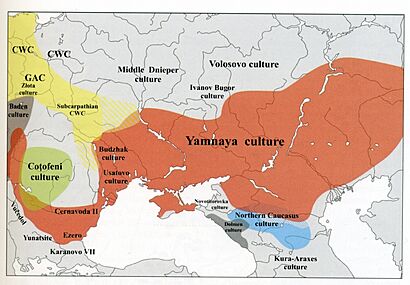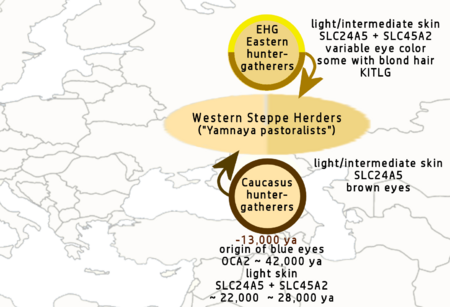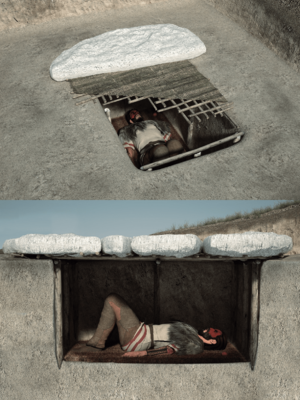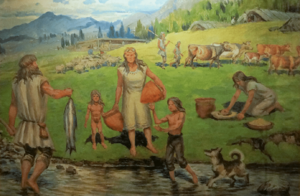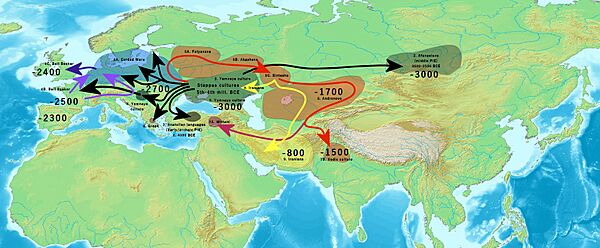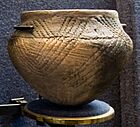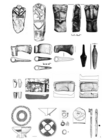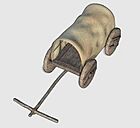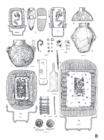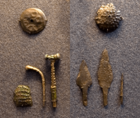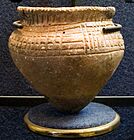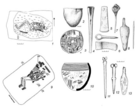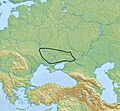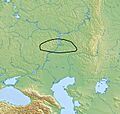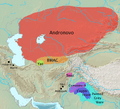Yamnaya culture facts for kids
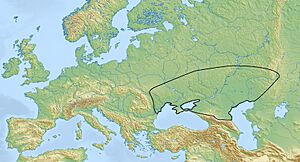 |
|
| Alternative names |
|
|---|---|
| Geographical range | Pontic–Caspian steppe in Europe |
| Period | Copper Age, Bronze Age |
| Dates | c. 3300 – 2600 BCE |
| Preceded by | Sredny Stog culture, Samara culture, Khvalynsk culture, Dnieper–Donets culture, Repin culture, Maykop culture, Cucuteni–Trypillia culture, Cernavodă culture, Usatove culture, Novosvobodnaya culture |
| Followed by |
North: Corded Ware culture
West: Catacomb culture, Vučedol culture East: Poltavka culture |
| Defined by | Vasily Gorodtsov |
The Yamnaya culture (also called the Yamna culture) was an ancient group of people who lived from about 3300 to 2600 BCE. They lived in the vast grasslands of the Pontic–Caspian steppe in Europe. This area is between the Southern Bug, Dniester, and Ural rivers.
The name "Yamnaya" comes from the Russian word "yama," which means "pit" or "hole." This is because these people buried their dead in special pit graves. These graves were often covered by large mounds of earth called kurgans.
The Yamnaya people were mostly nomads. This means they moved around a lot with their animals. They were skilled at raising animals like cattle and sheep. They also used wheeled carts and wagons to help them move their herds and homes.
This culture is important because it's linked to the spread of Indo-European languages. Many languages spoken today, from Europe to India, come from this ancient language.
Contents
Where the Yamnaya People Came From
Scientists are still learning about exactly where the Yamnaya culture began. It seems to have developed from earlier cultures in the same region. These include the Khvalynsk culture and the Sredny Stog culture.
The Yamnaya culture quickly spread across the wide grasslands of the Pontic-Caspian steppe. This fast spread might have been because they were good at moving around. They used wheeled carts and wagons, which were new inventions at the time. This allowed them to manage large groups of animals and travel far.
Some experts believe that as the Yamnaya people moved, they also spread their language. This language is thought to be an early form of what we call Proto-Indo-European.
How the Yamnaya People Lived
The Yamnaya people were mainly animal herders. They raised cattle, sheep, and goats. They also did some fishing and gathered wild plants for food. They made their own ceramics, tools, and weapons.
They were mostly nomadic, meaning they didn't stay in one place for long. They lived in chiefdoms, which are groups led by a chief. Their wheeled carts and wagons were very important for their nomadic lifestyle. They helped them move their large herds of animals.
The Yamnaya people were also skilled metalworkers. They made tools and weapons from metal. Important people in their society, like metalworkers, were given special status.
Their diet mainly consisted of meat and dairy products. They likely ate meat, drank milk, and made yogurt and cheese. They might have also eaten soups made from seeds and wild vegetables.
Yamnaya Burials
A key feature of the Yamnaya culture is their unique burial style. They buried their dead in deep pits. These pits were then covered by large earth mounds called kurgans. Sometimes, they offered animals as gifts in the graves.
Some graves also had large stone statues called Kurgan stelae. These statues were carved to look like people. They showed human heads, arms, hands, belts, and weapons. The bodies were usually placed on their backs with bent knees. They were often covered in a red powder called ochre.
Not everyone was buried in a kurgan. These special burials might have been for important adults, often men. The items buried with them, and how they were placed, showed their status and gender. In some areas, important people were even buried with full wooden wagons.
Horses and Carts
The Yamnaya culture used two-wheeled carts and four-wheeled wagons. These were likely pulled by oxen. There is also evidence that they rode horses. Some Yamnaya skeletons show signs that suggest they spent a lot of time riding horses. This shows how important horses were to their way of life.
Their DNA Story
Scientists have studied the DNA of Yamnaya people. They found that the Yamnaya people were a mix of two main groups. One group was "Eastern European Hunter-Gatherers" (EHG). The other group was "Caucasus Hunter-Gatherers" (CHG). These two groups each contributed about half of the Yamnaya DNA. This mix is often called "Steppe ancestry."
This "Steppe ancestry" is found in many people today, especially in Europe and parts of Asia. This suggests that the Yamnaya people moved and mixed with other groups.
The Yamnaya people likely had brown eyes, light to medium skin, and brown hair. Some may have had a gene linked to blond hair. They also had a gene that might have helped them digest milk as adults. This gene likely spread to Europe through their migrations.
Their Language
Many experts believe that the Yamnaya people spoke an early form of the Proto-Indo-European language. This language is the ancestor of many languages spoken today, from English and Spanish to Hindi and Persian.
The idea is that the Pontic-Caspian steppe, where the Yamnaya lived, was the original homeland of this language. As the Yamnaya people moved and spread, their language also spread.
Some scientists think that the early Indo-European language developed through trade and interactions. This happened in the area around the Black Sea, even before the Yamnaya culture fully formed.
Spreading Out
The Yamnaya culture had a big impact on other cultures. Their genes and ideas spread far and wide.
Moving West into Europe
Genetic studies show that the Yamnaya people's DNA is very similar to that of the Corded Ware culture people in Central and Eastern Europe. This suggests a strong connection between them. Today, many people in Central and Northern Europe have a significant amount of Yamnaya-like ancestry.
When farming first came to Western and Southern Europe, it was brought by people from Anatolia. But in the Baltic region (Northern Europe), the arrival of farming seems to have happened at the same time as the arrival of people with Yamnaya-like ancestry.
Moving East into Asia
The Yamnaya people's influence also reached Central and South Asia. Their ancestry is found in many groups there, especially those who speak Indo-Aryan languages.
The spread of Yamnaya-related ancestry into Central and South Asia was complex. It involved different groups moving and mixing over time. This included groups similar to the Corded Ware and Sintashta cultures.
Even later groups, like the ancient Scythians (nomads from the Iron Age), show a mix of Yamnaya-related ancestry and East Asian ancestry. This shows how far and wide the Yamnaya genetic legacy spread.
Gallery
-
Yamnaya burials from Moldova
-
Cis-Ural Yamnaya artefacts and burials
-
Horses were domesticated on the Pontic-Caspian steppe.
Images for kids
-
Map of the approximate maximal extent of the Andronovo culture. The formative Sintashta-Petrovka culture is shown in darker red. The location of the earliest spoke-wheeled chariot finds is indicated in purple. Adjacent and overlapping cultures (Afanasevo culture, Srubna culture, Bactria–Margiana Archaeological Complex) are shown in green.
-
Archaeological cultures associated with Indo-Iranian Indo-Iranian migration and Indo-Aryan peoples migrations (after EIEC). The Andronovo culture, BMAC and Yaz cultures have often been associated with Indo-Iranians migrations. The Gandhara grave culture, Cemetery H culture, Copper Hoard Culture and Painted Grey Ware culture cultures are candidates for cultures associated with Indo-Aryan peoples migrations.
See also
- Kurgan
- Kurgan stelae
- Beaker culture
- Khvalynsk culture
- Sintashta culture
- Proto-Indo-Europeans


